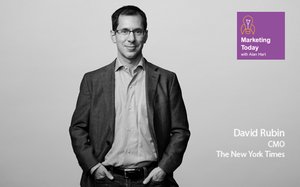
This week on
“Marketing
Today,” I speak with David Rubin, CMO of The New York Times.
Rubin had a somewhat unexpected career beginning for a marketer. Right after college, he spent two years working on
Capitol Hill for a Milwaukee congressman and two years in the Treasury Department during the Clinton administration. Then he received an MBA from the Wharton School before joining Unilever.
During his 13 years at Unilever, Rubin worked in brand building, helping launch Axe body spray and leading the turnaround of its U.S. Hair division. After that, he spent two years at Pinterest as
head of global brand before joining the Times.
advertisement
advertisement
During the podcast, Rubin discusses how being a product of the Baltimore public school system shaped the way he builds teams, the fake
news phenomenon, the recent TV-focused work he’s overseen in marketing the Times, and the paper’s shift from an advertising-based business model to one that is
subscription-first.
“What we find is that the more we grow our consumer base and connection with the end user, the better our ad business gets," Rubin says. "And that may be
counterintuitive, but they come together.
"Ultimately, what advertisers want is a deeply engaged audience that they can sell their message to in appropriate ways. The Times has
that, more than it’s ever had. And so, we see the two things as actually more synergistic from a business-model perspective. Having the consumer-subscription-first mindset lifts all
boats.”
Highlights from this week’s “Marketing Today” podcast include:
- From Capitol Hill and the Clinton administration to Unilever, Pinterest,
and The New York Times, all the roles Rubin has held were meant to create mass impact. (1:20)
- Rubin talks about the TV spot that launched the Times campaign
“The Truth Is
Hard." (5:40)
- “Quality reporting really does matter” — Rubin discusses the impact of the fake news phenomenon. (11:22)
- “He said. She
said.” Rubin reflects upon the NYT’s first extension of “The Truth Is Hard” campaign: “The Truth Has a Voice.” (14:13)
- From advertising-based to subscription-first: the evolution of The New York Times business model. (24:19)
- Rubin talks cooking and crossword
puzzles. (26:37)
- “Journalism happens in real time, and it’s messy.” (29:29)
- “We seek the truth, and we help people understand the
world.” (32:00)